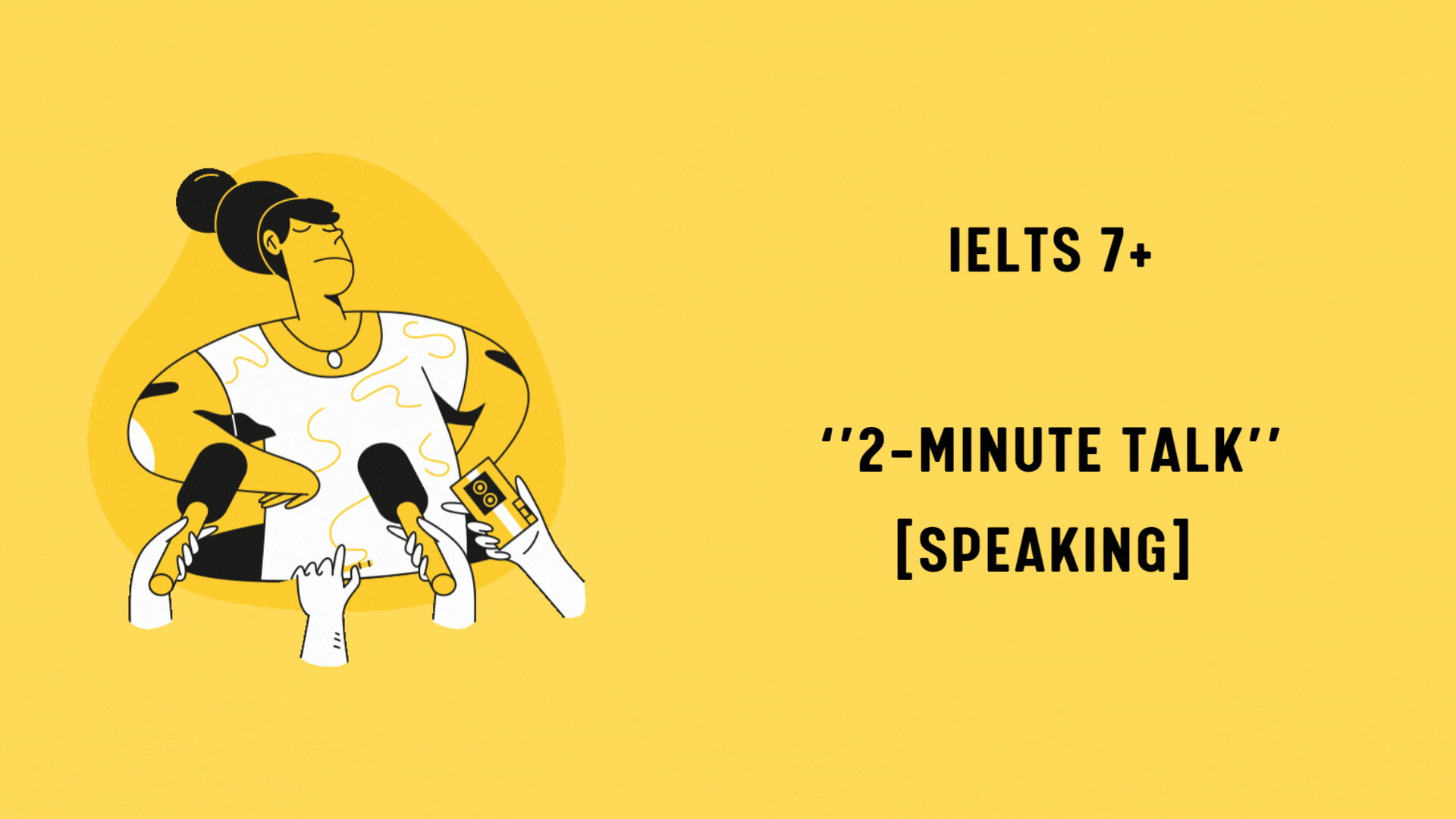How to Master IELTS Speaking Part 2: Perfecting Your 2-Minute Talk
Master IELTS Speaking Part 2 with tips on organizing your 2-minute talk, avoiding common mistakes, and boosting your score. Learn how to structure, expand, and speak naturally!
Zeena K.
11/1/20246 min read


If you’re prepping for the IELTS Speaking Test, you know that Part 2 can feel like a make-or-break moment. This is where the examiner hands you a topic card, gives you a minute to prepare, and expects you to talk for 1-2 minutes without stopping. Sounds intense, right? But with the right strategy, you can master this 2-minute talk and seriously boost your score. Let’s break down how to nail it!
What to Expect in IELTS Speaking Part 2
Part 2 of the IELTS Speaking Test, also called the “long turn,” is where you’ll have a chance to shine by speaking at length on a specific topic. Here’s how it goes down:
You’ll get a topic card with a subject and a few bullet points to guide your response.
You’ll have one minute to prepare, then need to speak for up to two minutes.
The examiner will listen without interrupting, giving you full control to showcase your fluency, vocabulary, coherence, and confidence.
Think of it as a mini-presentation. This part of the test evaluates how well you can organize your thoughts and speak confidently under pressure—both of which are essential skills for scoring a Band 7 or higher.
Common Topics for Part 2
While the specific topics vary, some common Part 2 themes include:
Describing a favourite book, movie, or song
Talking about a memorable trip or event
Describing a person you admire
Discussing a skill you want to learn
You can find practice questions on websites like IELTS.org to get comfortable with a range of topics. Reviewing a few sample topics will help you prepare without relying on memorized answers.
Why the 2-Minute Talk is Key to a Higher Score
The 2-minute talk is crucial because it evaluates multiple aspects of effective communication:
Fluency: Are you able to talk smoothly without pausing too much?
Coherence: Can you organize your ideas logically and make your answer flow?
Vocabulary: Do you use a variety of vocabulary that’s appropriate for the topic?
Pronunciation: Is your speech clear, and do you use natural intonation?
Nailing Part 2 can make a big difference in your overall speaking score, as it demonstrates your ability to keep a conversation engaging, focused, and expressive.
Structuring Your Answer:
The 4-Step Formula
Having a structure is key to delivering a well-organized answer. Here’s a simple 4-step formula that helps you stay on track during your 2-minute talk:
Introduction
Start by directly introducing the topic. If the card says, “Describe a book you enjoyed,” you might say, “One of my all-time favourite books is ‘To Kill a Mockingbird’ by Harper Lee.”Details
This is your chance to add some depth. Describe important aspects of the topic that make it memorable or unique. Continuing with the book example, you might talk about the setting, main characters, or plot elements that captivated you.Personal Connection
Connect the topic back to yourself. Why does it matter to you? A personal touch not only shows engagement but also makes your answer sound natural and relatable.Conclusion
Wrap up with a closing thought. For instance, “Overall, this book taught me a lot about empathy and justice, which is why it stands out in my mind.” This rounds off your answer and leaves a positive impression.
By following these four steps, you’ll sound organized and confident, and your response will be easy for the examiner to follow.
Timing Tips: How to Fill 2 Minutes Confidently
The clock can feel like your enemy in Part 2, but it doesn’t have to be! With practice, you can fill the full 2 minutes without feeling rushed or stretched.
Tips for Staying Within the 2-Minute Mark
Use All Prompts on the Card
The prompts on the topic card are there to help you structure your talk. Make sure to touch on each point, as this not only adds variety but also keeps your answer relevant and thorough.Add Descriptive Details
Descriptions help paint a clear picture and fill time naturally. For instance, if you’re talking about a memorable trip, describe what the place looked like, what you did, and any memorable experiences.Expand on Ideas with Examples
Examples make your response richer and more engaging. If you’re describing a person you admire, don’t just say they’re “kind” or “intelligent”—give a quick example of something they did that left an impact on you.Practice Pacing with a Timer
To build a natural pace, practice with a timer. This helps you avoid rushing or trailing off too early, and you’ll get a better feel for how long 2 minutes actually feels when you’re speaking.
Developing Ideas Quickly with Mind Mapping
Got just one minute to plan? Mind mapping is a lifesaver for organizing thoughts fast! Here’s how to use it effectively:
Start with the Topic: In the center of your paper, jot down the main topic (like “favorite book”).
Branch Out with Details: Quickly add branches with supporting ideas, like “plot,” “characters,” or “personal impact.”
Link Personal Connections: Add thoughts on how the topic relates to you, so you’re ready to make it engaging.
This quick map gives you a visual plan and helps prevent blanking out. Tools like MindMeister let you practice creating mind maps if you’d like to develop this skill further.
Final Thoughts: Mastering Part 2 Like a Pro
The 2-minute talk doesn’t have to be daunting. With the right approach—using a structured answer, pacing yourself, and practising consistently—you’ll be ready to tackle any topic the examiner throws your way. So, go out there, practice smart, and let your speaking skills shine! 💪
Vocabulary Tips for Part 2 Topics
Using varied and relevant vocabulary in Part 2 is essential for a higher score. Here’s how to do it without sounding forced:
Use Synonyms
Avoid repeating the same words. If you’re talking about something you “like,” use words like “enjoy,” “appreciate,” or “am fond of.” Synonyms add variety, which shows vocabulary range.Include Topic-Specific Words
Using vocabulary related to the topic (like “plot” or “character” if talking about a book) makes your response sound more knowledgeable and natural.Practice Idioms Sparingly
An idiom or two can give your response character, but don’t overuse them. A well-placed phrase, like “it was a breath of fresh air,” adds flavor without overwhelming the response.Connect Words Smoothly
Instead of forcing fancy words, focus on fluency and connecting words naturally. If you’re unsure about a word, go for clarity with simpler language. This resource on vocabulary can help you find synonyms for common words.
Sample Part 2 Topics with Band 7+ Answer Breakdown
Let’s look at some sample topics with answers that would score well, along with a breakdown of what makes them effective:
Sample Topic: Describe a person who inspires you.
Sample Answer:
“One person who really inspires me is Malala Yousafzai. She’s not only an advocate for girls’ education but also someone who has shown immense courage. When I first learned about her story, I was struck by her determination to keep fighting for what she believed in, even after facing life-threatening situations. I admire her resilience and hope to show that kind of bravery in my own life.”
Why it Works:
Fluency: The answer flows naturally without hesitation.
Vocabulary: Words like “advocate,” “courage,” and “resilience” add depth.
Coherence: It’s structured well, introducing Malala and then giving specific reasons for admiration.
Common Mistakes in Part 2 and How to Avoid Them
Here are some common pitfalls in Part 2 and tips on how to sidestep them:
Going Off-Topic
Fix: Focus on each prompt from the topic card. Answer each one briefly to stay focused.Sounding Memorized
Fix: Avoid pre-planned answers by practicing different responses. This helps you sound natural and ready for any topic.Rushing Through the Answer
Fix: Pause between sentences and take a breath. Pausing naturally makes you sound more confident and lets you control the flow of your answer.Overloading on Fancy Vocabulary
Fix: Choose words that you know well and use them confidently. It’s better to be clear than complex.Ignoring Pronunciation and Intonation
Fix: Practice speaking with natural intonation. It helps make your response engaging, even if your accent isn’t native.
Practice Tips to Nail the 2-Minute Talk
Effective practice makes all the difference in acing Part 2. Here’s how to practice smart:
Use Online Resources: Websites like IELTS.org and British Council offer free sample tests, helping you get comfortable with the test structure and timing.
Record Your Responses: Listening to yourself will help you catch patterns like overusing certain words, rushing, or pausing too much. Self-evaluation is one of the best tools for improvement.
Seek Feedback: Practicing with a tutor or English-speaking partner allows you to receive valuable feedback on your pronunciation, vocabulary, and coherence. Honest feedback is essential for progress!








